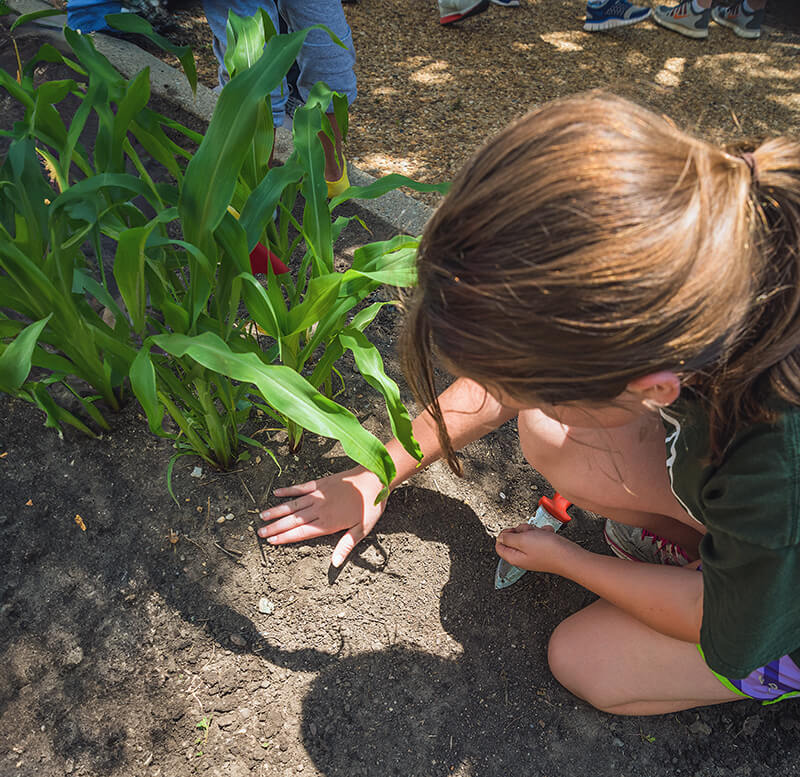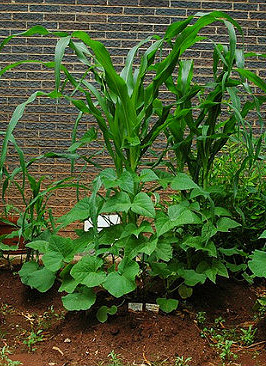Three Sisters Garden
Students investigate the "three sisters" crops (corn, beans, and squash) and explore the benefits of planting these crops together.

Background
Lesson Activities
Recommended Companion Resources
Credits
Author
Sue Knott | Minnesota Agriculture in the Classroom
Acknowledgements
- Background information and aspects of the lesson were adapted from The National Gardening Association's kidsgardening.org
- Three Sisters Garden photo credited to Abri Le Roux.
Standards
Indiana Content Area Standards
-
English Language Arts.Grade 3.RL.1
Read and comprehend a variety of literature within a range of complexity appropriate for grades 2-3. By the end of grade 3, students interact with texts proficiently and independently.
- Key Ideas and Textual Support.3.RL.2.1: Ask and answer questions to demonstrate understanding of a text, referring explicitly to the text as the basis for the answers.
- Key Ideas and Textual Support.3.RL.2.2: Recount folktales, fables, and tall tales from diverse cultures; identify the themes in these works. Further guidance for support will be provided in the Literacy Framework.
- Key Ideas and Textual Support.3.RL.2.3: Describe characters in a story (e.g., their traits, motivations, or feelings) and explain how their actions contribute to the plot.
-
English Language Arts.Grade 3.SL.1
Listen actively and adjust the use of spoken language (e.g., conventions, style, vocabulary) to communicate effectively with a variety of audiences and for different purposes.
- Discussion and Collaboration.3.SL.2.1: Engage effectively in a range of collaborative discussions (one-on-one, in groups, and teacher-led) on grade- appropriate topics and texts, building on others ideas and expressing personal ideas clearly.
- Discussion and Collaboration.3.SL.2.2: Explore ideas under discussion by drawing on readings and other information.
- Discussion and Collaboration.3.SL.2.4: Ask questions to check understanding of information presented, stay on topic, and link comments to the remarks of others.
- Discussion and Collaboration.3.SL.2.5: Explain personal ideas and understanding in reference to the discussion.
-
English Language Arts.Grade 4.RL.1
Read and comprehend a variety of literature within a range of complexity appropriate for grades 4-5. By the end of grade 4, students interact with texts proficiently and independently at the low end of the range and with scaffolding as needed at the high end.
- Connection of Ideas.4.RL.4.2: Compare and contrast the treatment of similar themes and topics and patterns of events in stories, myths, and traditional literature from different cultures.
- Key Ideas and Textual Support.4.RL.2.1: Refer to details and examples in a text when explaining what a text says explicitly and when drawing inferences from the text.
- Key Ideas and Textual Support.4.RL.2.2: Paraphrase or summarize the main events in a story, myth, legend, or novel; identify the theme and provide evidence for the interpretation.
- Key Ideas and Textual Support.4.RL.2.3: Describe a character, setting, or event in a story or play, drawing on specific details in the text, and how that impacts the plot.
-
English Language Arts.Grade 4.SL.1
Listen actively and adjust the use of spoken language (e.g., conventions, style, vocabulary) to communicate effectively with a variety of audiences and for different purposes.
- Discussion and Collaboration.4.SL.2.2: Explore ideas under discussion by drawing on readings and other information.
- Discussion and Collaboration.4.SL.2.4: Pose and respond to specific questions to clarify or follow up on information, and make comments that contribute to the discussion and link to the remarks of others.
- Discussion and Collaboration.4.Sl.2.5: Review the key ideas expressed and explain personal ideas in reference to the discussion.
-
English Language Arts.Grade 5.RL.1
Read and comprehend a variety of literature within a range of complexity appropriate for grades 4-5. By the end of grade 5, students interact with texts proficiently and independently.
- Connection of Ideas.5.RL.4.2: Compare and contrast stories in the same genre on their approaches to similar themes and topics.
- Key Ideas and Textual Support.5.RL.2.1: Quote accurately from a text when explaining what a text says explicitly and when drawing inferences from the text.
- Key Ideas and Textual Support.5.RL.2.3: Describe two or more characters, settings, or events in a story or play, drawing on specific details in the text, and how they impact the plot.
-
English Language Arts.Grade 5.SL.1
Listen actively and adjust the use of spoken language (e.g., conventions, style, vocabulary) to communicate effectively with a variety of audiences and for different purposes.
- Discussion and Collaboration.5.SL.2.2: Reflect on and contribute to ideas under discussion by drawing on readings and other resources.
- Discussion and Collaboration.5.SL.2.4: Pose and respond to specific questions by making comments that contribute to the discussion and elaborate on the remarks of others.
- Discussion and Collaboration.5.SL.2.5: Review the key ideas expressed and draw conclusions in reference to information and knowledge gained from the discussions.
-
Social Studies. Grade 4: History: Standard 1
Students trace the historical periods, places, people, events, and movements that have led to the development of Indiana as a state.
- 4.1.2 American Indians and the Arrival of Europeans to 1770: Identify and describe historic Native American Indian groups that lived in Indiana at the time of early European exploration, including ways these groups adapted to and interacted with the physical environment.
-
Social Studies. Grade 5: History: Standard 1
Students describe the historical movements that influenced the development of the United States from pre-Columbian times up to 1800, with an emphasis on the American Revolution and the founding of the United States.
- 5.1.3 Ways of Life Before and After the Arrival of Europeans to 1610: Compare and contrast historic Indian groups of the West, Southwest, Northwest, Arctic and sub-Arctic, Great Plains, and Eastern Woodlands regions at the beginning of European exploration in the late fifteenth and sixteenth centuries.
- 5.1.6 Colonization and Settlements: 1607 to 1763: Identify and explain instances of both cooperation and conflict that existed between Native American Indians and colonists.
